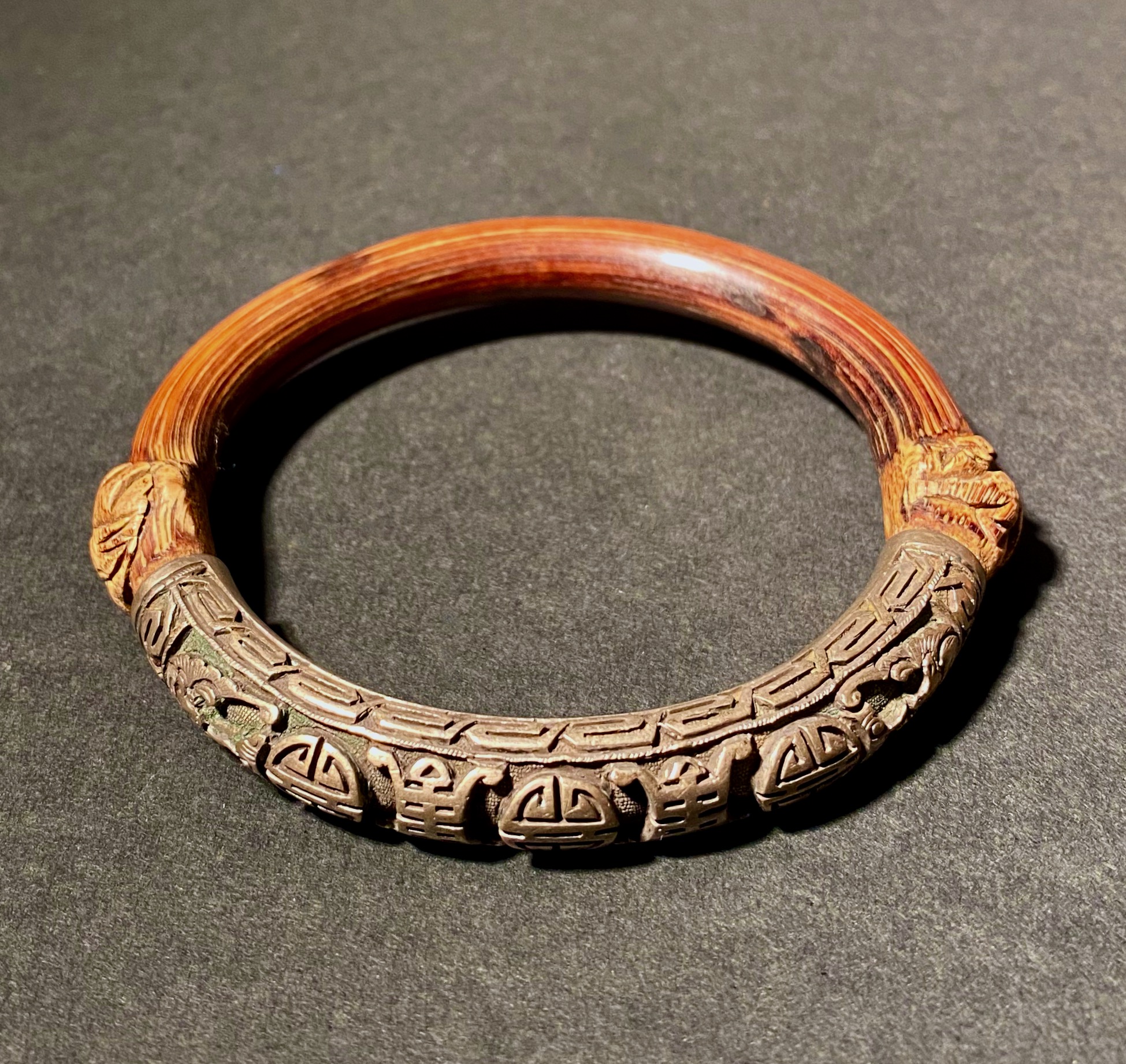

Title: 19th century antique Chinese bamboo and silver bracelet
Shipping: $29.00
Artist: N/A
Period: 19th Century
History: Art
Origin: Central Asia > China
Condition: N/A
Item Date: N/A
Item ID: 529
This is an Exquisite piece of Antique Jewelry: 19th Century Chinese Bamboo and Silver Bracelet Behold this spectacular antique jewelry piece—a 19th-century Chinese bamboo and silver bracelet exquisitely engraved to perfection. Its dimensions measure 2 1/2 inches on the inside and 3 1/8 inches on the outside. This piece originates from the late 1800s, showcasing a beautiful patina that attests to its age, all while maintaining a fantastic condition that speaks to its enduring quality. The integration of bamboo and silver in jewelry holds a fascinating history within Chinese craftsmanship. This unique combination has been a hallmark of Chinese jewelry design for centuries, embodying both cultural significance and artistic excellence. In traditional Chinese culture, bamboo is revered for its symbolism of resilience, flexibility, and longevity. These qualities are often associated with human virtues, making bamboo a meaningful motif in various art forms, including jewelry. Silver, on the other hand, is valued for its intrinsic beauty and malleability, allowing artisans to craft intricate designs and capture delicate details. The use of bamboo and silver together in jewelry, especially in the creation of bracelets, showcases the harmonious blend of natural elements and precious metals. The process typically involves intricately weaving or carving bamboo elements and integrating them with finely crafted silver components. This fusion results in pieces that not only showcase the artistic skills of the craftsmen but also carry profound cultural and symbolic meanings. Bamboo and silver bracelets are often adorned with intricate engravings, depicting scenes from nature, mythology, or cultural motifs. These engravings not only add to the aesthetic appeal of the piece but also convey stories and messages that hold significance within Chinese traditions. The popularity of bamboo and silver-integrated jewelry reached its zenith during the 19th century, a time of great artistic innovation and cross-cultural influences. Chinese artisans mastered the art of combining these materials, resulting in bracelets that were not only visually stunning but also durable and functional. The enduring appeal of bamboo and silver integrated jewelry lies in its ability to bridge the gap between the natural world and the realm of precious metals. These pieces continue to be cherished as heirlooms and collector's items, reflecting both the artistic mastery of their creators and the deep-rooted cultural values they embody. In essence, the history of bamboo and silver integration in Chinese jewelry narrates a story of craftsmanship, symbolism, and cultural expression that continues to captivate and inspire admirers around the world.
The history of jewelry in China dates back thousands of years, with evidence of jewelry-making and adornment found in archaeological discoveries. The exact age of the first Asian jewelry discovered in China can vary depending on the specific archaeological site and findings. However, some of the earliest instances of jewelry in China can be traced back to the Neolithic period. Jade, in particular, holds a significant place in ancient Chinese jewelry. Jade ornaments and artifacts have been unearthed from Neolithic sites, such as the Hongshan Culture (circa 4700–2900 BCE) and the Liangzhu Culture (circa 3400–2250 BCE). These cultures are known for their intricate jade carvings, which were used for personal adornment, rituals, and burial practices. During the Shang Dynasty (1600–1046 BCE), advancements in metalworking techniques allowed for the creation of more elaborate and intricate jewelry pieces. Bronze was used to craft decorative ornaments, often adorned with intricate designs and inscriptions. These items were not only symbols of status and wealth but also played important roles in religious ceremonies and ancestor worship. As time progressed, jewelry-making in China evolved, incorporating various materials such as gold, silver, pearls, and precious stones. The intricate craftsmanship and symbolic meanings associated with jewelry continued to be a significant aspect of Chinese culture throughout different dynasties and historical periods. It's important to note that the discovery of ancient jewelry is an ongoing process, and new archaeological findings can reshape our understanding of the timeline and development of jewelry in China. Therefore, while there are ancient artifacts that provide insights into the earliest Asian jewelry in China, the precise age of the very first piece may remain a subject of ongoing research and discovery.